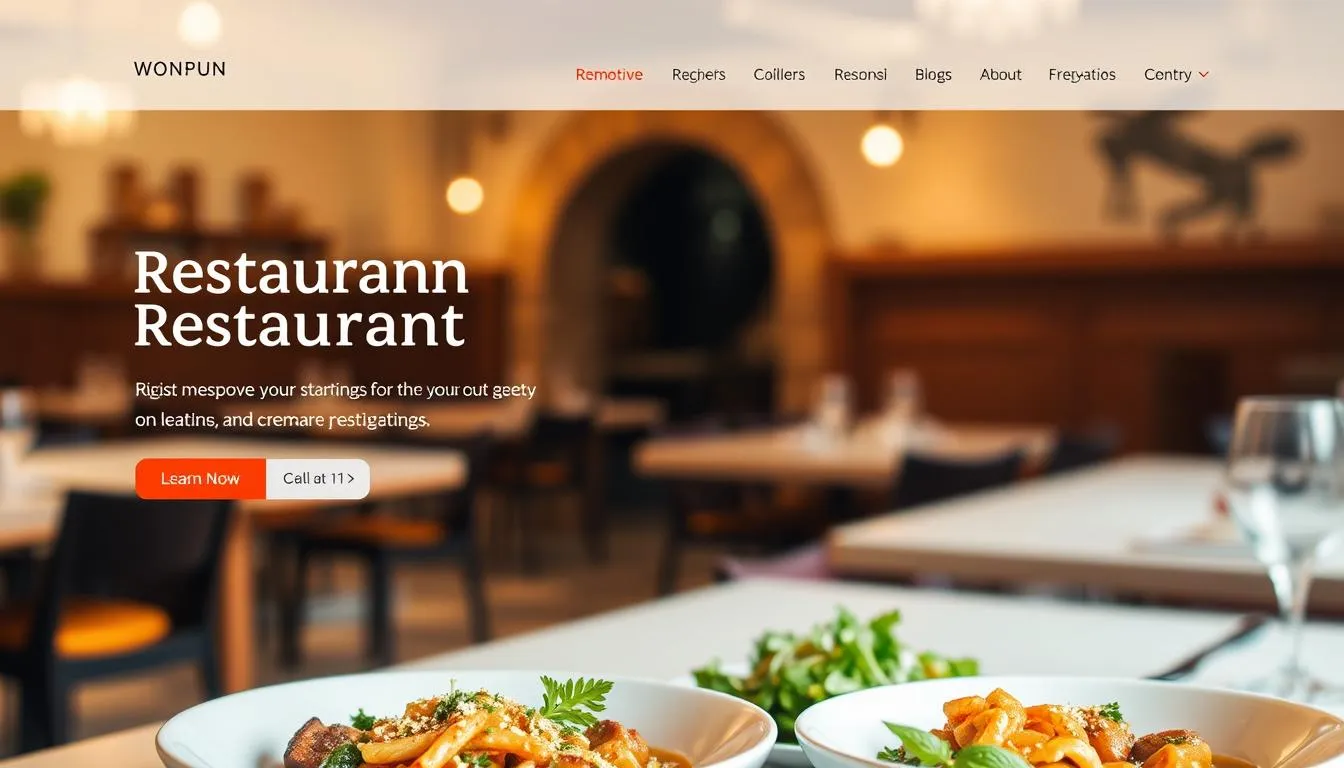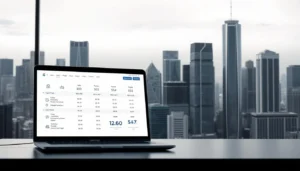Last Updated on: June 19, 2025
In today’s digital age, having a restaurant website is crucial for attracting customers and establishing a strong online presence. A well-designed website serves as a digital storefront, allowing potential customers to discover your restaurant and get a feel for your brand.
A restaurant website not only enhances your online visibility but also drives sales by providing a platform for customers to learn about your menu, make reservations, and order online. By investing in a professional website, you can attract new customers and retain existing ones, ultimately boosting your revenue.
Key Takeaways
- Enhance your online visibility with a professional restaurant website.
- Attract new customers and retain existing ones through a well-designed website.
- Drive sales by providing a platform for online ordering and reservations.
- Establish a strong online presence and stand out from the competition.
- Boost revenue through increased customer engagement and loyalty.
The Digital Dining Revolution: Why Your Restaurant Needs a Website
The way customers find and interact with restaurants has undergone a significant transformation in the digital age. This shift is driven by the increasing reliance on online platforms for discovering and engaging with dining options.
The Changing Customer Journey in the Restaurant Industry
The customer journey in the restaurant industry has become more complex and digitally driven. Customers now research, review, and often decide on a restaurant online before even stepping foot inside. This change underscores the importance of having a robust online presence, starting with a well-designed website that can cater to the evolving needs and expectations of diners.
Statistics on Online Restaurant Discovery and Decision-Making
Recent statistics highlight the significance of online discovery in the restaurant industry. For instance, a considerable percentage of consumers use online review sites and search engines to find new dining options. Here’s a snapshot of how customers discover and decide on restaurants online:
Having a strong online presence is crucial for restaurants to attract and retain customers in this digital age. By understanding these trends and adapting to the changing customer journey, restaurants can better position themselves for success.
How to Attract More Customers with a Restaurant Website?
Your restaurant’s website is often the first point of contact with potential customers, making it a critical component of your marketing strategy. To maximize its effectiveness, you need to understand your audience, set clear goals, and analyze your competitors.
Understanding Your Restaurant’s Target Audience
Identifying your target audience is crucial for creating a website that resonates with potential customers. Consider demographics such as age, location, and dining preferences to tailor your content and design. For instance, a restaurant catering to families with young children might prioritize kid-friendly menu options and entertainment.
Setting Clear Goals for Your Online Presence
Defining clear goals for your restaurant website helps guide its development and measurement of success. Whether it’s increasing online orders, boosting reservations, or enhancing brand awareness, having specific objectives in mind will help you create a more effective online presence. Use metrics such as website traffic, engagement rates, and conversion rates to assess your progress.
Analyzing Competitor Restaurant Websites
Conducting a competitor analysis can provide valuable insights into what works and what doesn’t in your niche. Look at the design, functionality, and content of competing restaurant websites to identify gaps and opportunities. For example, if many competitors have online ordering but yours doesn’t, it might be worth considering.
By understanding your audience, setting clear goals, and analyzing your competitors, you can create a restaurant website that not only attracts more customers but also provides a solid foundation for your online presence.
Essential Elements of an Effective Restaurant Website
An effective restaurant website serves as the digital face of the establishment, influencing customer perceptions and driving sales. To achieve this, several key elements must be incorporated into the website design.
User-Friendly Navigation and Design
A user-friendly navigation system is crucial for ensuring that visitors can easily find the information they’re looking for. This includes having a clear menu, prominent calls-to-action, and a responsive design that adapts to various devices. A well-designed website will keep visitors engaged and encourage them to explore further.
High-Quality Food and Ambiance Photography
High-quality photography is essential for showcasing the restaurant’s offerings and ambiance. This includes using high-resolution images of dishes, the dining area, and other relevant aspects of the restaurant. Such visuals help to stimulate appetite and give potential customers a sense of what to expect.
Clear Contact Information and Location Details
Making it easy for customers to get in touch or find the restaurant is vital. This involves displaying clear contact information, including phone numbers, email addresses, and physical locations. Integrating a map and providing directions can also enhance the user experience.
About Us: Telling Your Restaurant’s Story
The ‘About Us’ section allows the restaurant to share its story, highlighting its history, mission, and values. This personal touch can help build a connection with potential customers and differentiate the restaurant from competitors. By including images of the team or behind-the-scenes moments, the restaurant can further humanize its brand.
By incorporating these essential elements, a restaurant can create an effective website that not only attracts visitors but also converts them into loyal customers.
Creating a Mouth-Watering Online Menu
An enticing online menu can significantly enhance your restaurant’s online presence and attract more customers. A well-crafted menu not only showcases your culinary offerings but also reflects your restaurant’s brand and atmosphere.
Menu Design Best Practices for the Web
When designing your online menu, it’s essential to prioritize user experience. Use clear categories, high-quality images, and an intuitive layout to make navigation easy for customers. Ensure that your menu is easily accessible on both desktop and mobile devices.
Food Descriptions That Stimulate Appetite
Compelling food descriptions can make your dishes sound irresistible. Use vivid language to describe the flavors, ingredients, and preparation methods. For example, instead of simply listing “Grilled Chicken,” describe it as “Slow-grilled chicken breast, marinated in a blend of herbs and spices, served with a side of roasted vegetables.”
Pricing Strategies and Special Offers Display
Clearly displaying prices and special offers can influence customer decisions. Consider highlighting daily specials, combo meals, or limited-time offers. Use a clean and organized format to present pricing information, making it easy for customers to scan and understand.
By implementing these strategies, you can create an online menu that not only showcases your restaurant’s culinary delights but also drives customer engagement and sales.
Implementing Online Ordering and Reservation Systems
The modern restaurant landscape demands efficiency and convenience, making online ordering and reservation systems a necessity. By integrating these digital tools, restaurants can significantly enhance the customer experience, streamline operations, and ultimately drive sales.
Choosing the Right Online Ordering Platform
Selecting an appropriate online ordering platform is crucial for seamless integration with your restaurant’s existing systems. Consider platforms that offer customizable ordering pages, real-time order tracking, and integration with your point-of-sale (POS) system. Popular options include Upserve and Toast, known for their user-friendly interfaces and robust features.
Reservation System Integration Options
Reservation systems help manage table bookings efficiently. When choosing a reservation system, look for features like automated reminders, table management, and integration with your website and social media. OpenTable is a well-known solution that many restaurants use to manage their reservations.
Payment Processing Solutions
Secure payment processing is vital for online transactions. Restaurants should opt for payment gateways that offer robust security measures, such as PCI-DSS compliance, and support multiple payment methods. Integrating payment processing with your online ordering system simplifies the customer experience and reduces cart abandonment rates.
Streamlining the Customer Experience
To maximize the benefits of online ordering and reservation systems, focus on streamlining the customer experience. This includes ensuring that your website is mobile-friendly, loading times are quick, and the ordering and reservation processes are intuitive. Key features to implement include:
- Clear menu descriptions and pricing
- Simple navigation and minimal steps to complete an order or reservation
- Real-time updates on order status or reservation confirmations
By implementing these strategies, restaurants can create a more satisfying and efficient experience for their customers, leading to increased loyalty and positive word-of-mouth.
Mobile Optimization: Reaching Customers On-the-Go
In today’s fast-paced digital landscape, having a mobile-optimized restaurant website is no longer a luxury, but a necessity. With the majority of customers using their mobile devices to search for restaurants, a mobile-friendly website is crucial for attracting and retaining customers.
Responsive Design Essentials for Restaurant Websites
A responsive design is the foundation of a mobile-optimized website. It ensures that your website adapts seamlessly to different screen sizes and devices, providing an optimal user experience. Key elements of responsive design include flexible grids, images, and media queries that enable your website to adjust its layout according to the device being used.
Mobile-Specific Features That Drive Conversions
To maximize conversions, your mobile-optimized website should include mobile-specific features such as click-to-call buttons, online ordering and payment systems, and reservation integration. These features streamline the customer experience, making it easier for them to engage with your restaurant.
Testing and Improving Mobile Performance
Regular testing and optimization are crucial to ensuring your website performs well on mobile devices. This includes testing page load times, navigation, and overall user experience. By identifying and addressing any issues, you can improve your website’s mobile performance and drive more conversions.
By focusing on mobile optimization, responsive design, and mobile-specific features, you can create a seamless and engaging experience for your customers, ultimately driving more sales and growth for your restaurant.
Content Marketing Strategies for Restaurants
By implementing a robust content marketing strategy, restaurants can engage with their audience and build a strong online presence. Effective content marketing helps attract and retain customers, driving sales and fostering loyalty.
Blog Posts That Attract Food Enthusiasts
Blog posts are an excellent way to share your restaurant’s story, highlight culinary techniques, and showcase your chefs’ expertise. By creating engaging and informative content, you can attract food enthusiasts and encourage them to visit your restaurant. Topics might include behind-the-scenes kitchen stories, chef interviews, or seasonal menu previews.
Recipe Sharing and Chef Spotlights
Sharing recipes and spotlighting your chefs can add a personal touch to your restaurant’s brand. It allows customers to connect with your culinary team and understand your cooking philosophy. This can be done through blog posts, social media, or even video content on your website.
Event Promotion and Special Announcements
Using your website to promote events and special offers can drive engagement and encourage visits. Whether it’s a wine pairing dinner, a holiday-themed menu, or a special promotion, your content marketing efforts can help spread the word and attract new customers.
By incorporating these content marketing strategies, restaurants can create a compelling online presence that attracts and retains customers. Regularly updating your content keeps your audience engaged and interested in what your restaurant has to offer.
Local SEO Strategies for Restaurant Websites
Local SEO strategies can significantly boost a restaurant’s visibility in search results, making it easier for potential customers to find and visit the establishment. By optimizing their online presence for local search, restaurants can attract more diners and increase their revenue.
Google Business Profile Optimization
A well-optimized Google Business Profile is essential for local SEO success. This involves claiming and verifying the business listing, providing accurate and up-to-date information, and adding high-quality photos of the restaurant and its dishes. Regularly updating the profile with posts and offers can also enhance engagement.
Local Keywords and Content Strategies
Using local keywords in the website’s content can improve its visibility in local search results. This includes incorporating the city, state, or region into page titles, meta descriptions, and body content. Creating content that is relevant to the local audience, such as blog posts about local events or ingredients, can also help attract local customers.
Online Reviews Management and Response
Online reviews play a crucial role in local SEO and customer decision-making. Encouraging satisfied customers to leave reviews on platforms like Google and Yelp can enhance a restaurant’s online reputation. Responding promptly and professionally to both positive and negative reviews demonstrates a commitment to customer satisfaction.
Building Local Backlinks and Citations
Building high-quality backlinks from local sources and maintaining consistent citations across online directories can improve a restaurant’s local search rankings. This can be achieved by partnering with local businesses, participating in community events, and ensuring that the restaurant’s name, address, and phone number (NAP) are consistently listed across the web.
Social Media Integration and Promotion
By linking your restaurant website to social media, you can create a powerful online marketing strategy. This integration not only enhances your online presence but also drives more traffic to your website.
Connecting Your Website with Social Platforms
To start, you need to connect your restaurant website with various social media platforms. This can be done by adding social media links to your website, allowing customers to easily find and follow your social media profiles.
- Add social media icons to your website’s header or footer.
- Use plugins or widgets to display your social media feeds directly on your website.
- Ensure that your social media profiles are complete, up-to-date, and consistent with your brand identity.
Content Strategies That Drive Website Traffic
Creating engaging content on social media is crucial for driving traffic to your website. Here are some strategies to consider:
- Share behind-the-scenes stories and videos of your kitchen.
- Promote special offers, events, and new menu items.
- Utilize Instagram Stories and Facebook Live to engage with your audience.
Leveraging User-Generated Content and Food Influencers
User-generated content and influencer marketing can significantly boost your restaurant’s online presence. Encourage customers to share their dining experiences on social media by:
- Creating a branded hashtag and encouraging customers to use it.
- Running social media contests that incentivize customers to share photos or reviews.
- Partnering with local food influencers to promote your restaurant.
Running Effective Social Media Campaigns
To get the most out of your social media efforts, it’s essential to run effective campaigns. This involves:
- Setting clear goals and objectives for your campaigns.
- Using targeted advertising to reach your desired audience.
- Monitoring and analyzing your campaign results to optimize future efforts.
By implementing these strategies, you can enhance your restaurant’s online presence, drive more traffic to your website, and attract more customers.
Conclusion: Serving Up Digital Success for Your Restaurant
A well-designed restaurant website is crucial for achieving digital success in today’s competitive dining landscape. By understanding your target audience, creating a user-friendly online presence, and leveraging essential elements such as high-quality food photography and online ordering systems, you can attract more customers and drive sales.
Implementing effective content marketing strategies, optimizing for local SEO, and integrating social media can further enhance your online visibility. By streamlining the customer experience and providing a seamless online presence, you can establish your restaurant as a leader in the industry and achieve long-term digital success.
Ultimately, a restaurant website is not just a digital brochure; it’s a powerful tool for driving customer engagement, increasing revenue, and building a loyal customer base. By following the strategies outlined in this article, you can create a website that truly serves up digital success for your restaurant.
FAQ
What is the importance of having a restaurant website?
Having a restaurant website is crucial for enhancing online presence, driving sales, and attracting more customers. It allows customers to discover and interact with your restaurant online.
How do customers discover restaurants online?
Customers often discover restaurants through online searches, review sites, and social media platforms. A strong online presence helps your restaurant appear in these search results.
What are the essential elements of an effective restaurant website?
Essential elements include user-friendly navigation, high-quality food photography, clear contact information, and an ‘About Us’ section that tells your restaurant’s story.
How can I create a mouth-watering online menu?
To create an appealing online menu, follow best practices for menu design, write appetizing food descriptions, and effectively display pricing and special offers.
What are the benefits of implementing online ordering and reservation systems?
Online ordering and reservation systems streamline the customer experience, increase sales, and reduce no-shows. They also provide valuable data on customer behavior.
Why is mobile optimization important for restaurant websites?
Mobile optimization is crucial because many customers search for restaurants on their mobile devices. A responsive design ensures a smooth user experience across devices.
How can I leverage content marketing for my restaurant?
Content marketing strategies include creating engaging blog posts, sharing recipes, spotlighting chefs, and promoting events to attract and retain customers.
What local SEO strategies can improve my restaurant's visibility?
Optimizing your Google Business Profile, using local keywords, managing online reviews, and building local backlinks can improve your restaurant’s local search visibility.
How can I integrate social media with my restaurant website?
You can connect your website with social platforms, create content that drives traffic, leverage user-generated content, and run effective social media campaigns to promote your restaurant.
What are the benefits of a well-designed restaurant website?
A well-designed restaurant website enhances online presence, drives sales, and provides a competitive edge. It also allows customers to interact with your restaurant online, improving overall customer experience.




